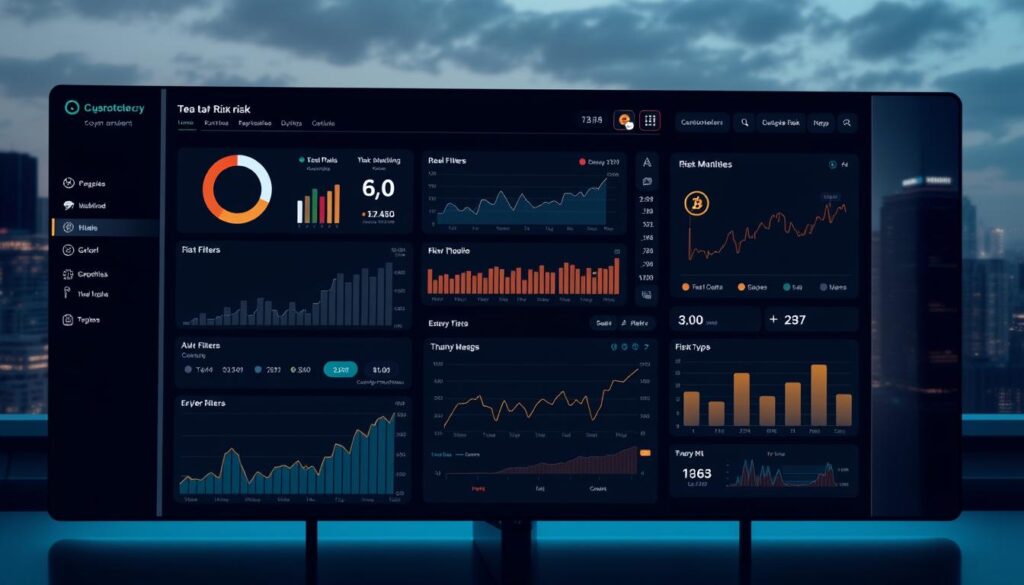Now Reading: Cryptocurrency Market Risk Analysis and Management Guide
- 01
Cryptocurrency Market Risk Analysis and Management Guide
Cryptocurrency Market Risk Analysis and Management Guide

Navigating the complex world of digital assets requires a strategic approach to cryptocurrency market risk management. Investors and traders face unprecedented challenges in this rapidly evolving financial landscape, where digital asset risk management becomes crucial for protecting investments.
The cryptocurrency market presents unique opportunities and significant risks that demand sophisticated analytical tools and comprehensive understanding. Successful navigation requires deep insights into market dynamics, technological innovations, and strategic risk mitigation techniques.
Cryptocurrency market risk encompasses multiple dimensions, from market volatility to regulatory uncertainties. Investors must develop robust strategies that address potential threats while capitalizing on emerging opportunities in the digital asset ecosystem.
Key Takeaways
- Understanding cryptocurrency market risk is essential for digital asset investments
- Comprehensive risk management strategies protect investor capital
- Digital asset markets require continuous monitoring and adaptive approaches
- Technology and analytical tools are critical for effective risk assessment
- Regulatory landscape plays a significant role in cryptocurrency market dynamics
Understanding Cryptocurrency Market Fundamentals
Cryptocurrency markets represent a dynamic and complex ecosystem that requires a deep understanding of its foundational elements. The crypto market basics encompass a revolutionary approach to digital finance, powered by innovative blockchain technology.
Blockchain technology serves as the critical infrastructure that enables cryptocurrency exchanges and digital asset transactions. This decentralized system provides transparency, security, and unprecedented financial opportunities for global participants.
Basic Components of Crypto Markets
The core components of cryptocurrency markets include:
- Digital assets and tokens
- Blockchain networks
- Cryptocurrency exchanges
- Trading platforms
- Market capitalization metrics
Key Market Participants
Successful navigation of crypto markets requires understanding the roles of various participants:
- Miners: Validate transactions and maintain blockchain networks
- Traders: Buy and sell digital assets for profit
- Developers: Create and improve blockchain protocols
- Investors: Hold long-term cryptocurrency positions
- Institutional players: Bring substantial capital and credibility
Market Infrastructure and Trading Mechanisms
Modern cryptocurrency exchanges offer sophisticated trading mechanisms that enable seamless digital asset transactions. These platforms provide order books, liquidity pools, and advanced trading tools that support efficient market operations.
Common Types of Cryptocurrency Market Risks
Cryptocurrency investors navigate a complex landscape filled with multiple risk dimensions. Understanding these risks is crucial for developing effective investment strategies and protecting digital assets from potential threats.
The crypto market volatility presents significant challenges for investors. Price fluctuations can occur rapidly, creating unpredictable financial environments where asset values can dramatically shift within hours or even minutes.
- Price Volatility: Extreme price swings characterize cryptocurrency markets
- Regulatory Risks: Uncertain legal frameworks across different jurisdictions
- Cybersecurity Threats: Potential for hacking and digital asset theft
- Technological Vulnerabilities: Smart contract and blockchain infrastructure risks
Regulatory risks remain a persistent concern for cryptocurrency investors. Governments worldwide continue to develop frameworks that could potentially impact digital asset trading, potentially introducing sudden legal constraints or reporting requirements.
| Risk Category | Potential Impact | Mitigation Strategy |
|---|---|---|
| Market Volatility | Rapid Price Fluctuations | Diversification, Stop-Loss Orders |
| Cybersecurity Threats | Asset Theft | Cold Storage, Multi-Signature Wallets |
| Regulatory Uncertainty | Legal Restrictions | Compliance Monitoring, Legal Consultation |
Cybersecurity threats continue to evolve, targeting cryptocurrency exchanges, individual wallets, and blockchain networks. Investors must remain vigilant and implement robust security measures to protect their digital assets from potential breaches.
Volatility Risk Assessment in Digital Asset Markets
Cryptocurrency markets represent a complex landscape of financial dynamics, where crypto volatility measurement becomes crucial for investors seeking to understand potential risks. Navigating these digital asset markets requires a sophisticated approach to analyzing price fluctuations and market behavior.
Investors must develop comprehensive strategies for price swing analysis to effectively manage their digital asset portfolios. Understanding the intricate mechanisms of market volatility can provide critical insights into potential investment opportunities and risks.
Measuring Historical Volatility
Historical volatility data serves as a fundamental tool for cryptocurrency risk assessment. Key methods of evaluation include:
- Standard deviation calculations
- Average true range analysis
- Statistical variance measurements
Predictive Volatility Models
Advanced investors leverage sophisticated predictive models to anticipate potential market movements. The most prominent approaches include:
- GARCH (Generalized Autoregressive Conditional Heteroskedasticity) Model
- Time series analysis techniques
- Machine learning prediction algorithms
Impact of Market Events on Price Swings
Market events can dramatically influence cryptocurrency price dynamics. Investors must carefully analyze external factors that trigger significant volatility.
| Market Event Type | Potential Volatility Impact | Typical Price Swing Range |
|---|---|---|
| Regulatory Announcements | High Volatility | 5-15% Price Movement |
| Major Exchange Listings | Medium Volatility | 3-8% Price Movement |
| Technological Upgrades | Low to Medium Volatility | 2-5% Price Movement |
By understanding these volatility assessment techniques, cryptocurrency investors can develop more robust risk management strategies and make informed investment decisions.
Regulatory and Compliance Risk Factors
Navigating the complex crypto regulations requires a deep understanding of the evolving regulatory landscape. Investors and businesses must stay informed about the intricate compliance requirements that shape digital asset interactions.
The United States has developed a multifaceted approach to cryptocurrency oversight. Key regulatory bodies like the Securities and Exchange Commission (SEC) and the Commodity Futures Trading Commission (CFTC) play critical roles in monitoring and managing digital asset markets.
- SEC focuses on classifying cryptocurrencies as securities
- CFTC regulates cryptocurrency derivatives and trading platforms
- Internal Revenue Service (IRS) provides tax guidance for crypto transactions
Compliance requirements demand rigorous Know Your Customer (KYC) and Anti-Money Laundering (AML) protocols. Cryptocurrency exchanges and financial institutions must implement robust verification processes to mitigate potential financial risks.
| Regulatory Body | Primary Responsibility | Key Focus Areas |
|---|---|---|
| SEC | Securities Regulation | Token classification, investor protection |
| CFTC | Derivatives Oversight | Crypto futures, market manipulation prevention |
| FinCEN | Financial Crime Prevention | AML compliance, suspicious activity reporting |
Businesses must develop comprehensive strategies to address the dynamic regulatory landscape. Proactive compliance involves continuous monitoring of legal developments, maintaining transparent operations, and implementing advanced risk management techniques.
Cryptocurrency Market Risk Analysis and Management Strategies
Navigating the complex world of cryptocurrency investments requires sophisticated crypto risk assessment techniques and robust portfolio management strategies. Investors must develop comprehensive approaches to minimize potential losses while maximizing risk-adjusted returns.
Successful digital asset management demands a multifaceted approach to understanding and mitigating market risks. Investors need to implement advanced analytical tools that provide deeper insights into market dynamics.
Quantitative Analysis Tools
Professional crypto investors rely on sophisticated quantitative tools to evaluate potential investments. Key tools include:
- Monte Carlo simulations for predicting market scenarios
- Regression analysis to identify market trends
- Machine learning algorithms for predictive modeling
Risk Metrics and Indicators
Critical risk metrics help investors make informed decisions about their cryptocurrency portfolios. Essential indicators include:
- Value at Risk (VaR) – Measuring potential loss probability
- Sharpe Ratio – Evaluating risk-adjusted performance
- Volatility index – Assessing market stability
Portfolio Optimization Techniques
Implementing modern portfolio theory in cryptocurrency investments requires strategic diversification and careful risk management. Investors can optimize their portfolios by:
- Balancing high-risk and low-risk digital assets
- Regularly rebalancing portfolio allocations
- Using correlation analysis to minimize overall portfolio risk
By integrating these advanced crypto risk assessment and portfolio management techniques, investors can develop more resilient investment strategies in the volatile digital asset marketplace.
Technical Analysis for Risk Assessment
Crypto technical analysis provides traders with powerful tools to evaluate market risks and potential price movements. By examining historical price data and trading patterns, investors can develop strategic insights into cryptocurrency market dynamics.

Successful crypto technical analysis relies on understanding key chart patterns and trading indicators that signal potential market shifts. Traders use various methods to interpret price movements and assess underlying risks.
- Head and Shoulders Pattern: Indicates potential trend reversals
- Double Tops/Bottoms: Signals potential trend changes
- Triangle Formations: Suggests potential breakout points
Critical trading indicators play a significant role in risk assessment. These tools help investors analyze market sentiment and predict potential price fluctuations.
| Indicator | Purpose | Risk Assessment Value |
|---|---|---|
| Moving Averages | Trend Identification | High |
| Relative Strength Index (RSI) | Momentum Measurement | Medium |
| MACD | Trend Confirmation | High |
Investors can leverage these crypto technical analysis tools to develop more robust risk management strategies. Understanding chart patterns and trading indicators empowers traders to make informed decisions in volatile cryptocurrency markets.
Fundamental Analysis in Crypto Markets
Cryptocurrency investors require sophisticated tools to evaluate digital assets beyond simple price movements. Blockchain analytics provide critical insights into the underlying health and potential of crypto projects. Understanding crypto fundamentals goes far beyond traditional financial analysis.
Investors can leverage multiple analytical approaches to assess cryptocurrency markets comprehensively. The integration of blockchain analytics with market sentiment indicators creates a powerful framework for informed decision-making.
On-Chain Analytics: Decoding Network Performance
On-chain analytics reveal crucial network dynamics through transparent blockchain data. Key metrics help investors understand cryptocurrency ecosystem performance:
- Transaction volume and frequency
- Active wallet addresses
- Token distribution patterns
- Network transaction fees
Network Health Indicators
Evaluating network robustness requires examining critical infrastructure metrics that signal long-term sustainability and security.
| Indicator | Significance | Interpretation |
|---|---|---|
| Hash Rate | Network Security | Higher rates indicate stronger protection |
| Node Distribution | Decentralization | Wider distribution suggests resilience |
| Mining Participation | Network Engagement | Indicates ecosystem vitality |
Market Sentiment Analysis
Crypto market sentiment represents the collective psychological state of investors. Advanced tools now track emotional and rational responses across various platforms:
- Social media trend analysis
- Cryptocurrency forums sentiment
- Fear & Greed Index tracking
- Trader perception monitoring
By combining blockchain analytics, network health indicators, and market sentiment analysis, investors can develop a comprehensive understanding of cryptocurrency market dynamics.
Risk Diversification Methods in Crypto Investing

Crypto portfolio diversification stands as a critical strategy for managing investment risk in the volatile digital asset landscape. Successful investors understand that spreading investments across multiple cryptocurrencies can significantly reduce potential losses and optimize overall portfolio performance.
Effective asset allocation in cryptocurrency investing requires a strategic approach. Investors should consider the following key diversification methods:
- Market Capitalization Spread
- Large-cap cryptocurrencies (Bitcoin, Ethereum)
- Mid-cap emerging blockchain platforms
- Small-cap potential high-growth tokens
- Blockchain Ecosystem Diversity
- DeFi platforms
- Layer-1 and Layer-2 blockchain networks
- NFT and metaverse projects
- Cross-Asset Allocation
- Digital assets
- Traditional financial instruments
- Stablecoins for risk mitigation
Risk management strategies demand careful analysis of cryptocurrency correlations. Investors should focus on selecting assets with minimal price correlation to create a robust portfolio.
| Diversification Category | Recommended Allocation (%) | Risk Profile |
|---|---|---|
| Large-Cap Cryptocurrencies | 50-60% | Low to Moderate |
| Mid-Cap Blockchain Platforms | 20-30% | Moderate |
| Emerging Token Projects | 10-20% | High |
Continuous monitoring and periodic rebalancing are essential for maintaining an effective crypto investment strategy. Investors should regularly evaluate their portfolio’s performance and adjust allocations based on market conditions and individual risk tolerance.
Security Measures for Crypto Asset Protection
Protecting cryptocurrency investments requires a comprehensive approach to cryptocurrency security. Digital assets face numerous threats, making robust protection strategies essential for investors and traders.
Investors can implement multiple layers of protection to safeguard their digital wealth. The following strategies provide critical defense mechanisms against potential security breaches:
- Utilize cold wallets for offline storage
- Implement multi-sig wallets for enhanced security
- Develop comprehensive backup protocols
- Enable two-factor authentication
Cold Storage Solutions
Cold wallets represent a critical component of cryptocurrency security. These hardware devices store private keys completely offline, dramatically reducing the risk of online hacking attempts. Popular cold storage options include:
| Device | Security Features | Price Range |
|---|---|---|
| Ledger Nano X | Bluetooth connectivity, secure element chip | $149-$179 |
| Trezor Model T | Touchscreen, open-source firmware | $169-$199 |
| KeepKey | Large display, metal construction | $99-$129 |
Multi-Signature Wallet Protocols
Multi-sig wallets provide an additional security layer by requiring multiple signatures to authorize transactions. This approach significantly reduces the risk of unauthorized access, making it particularly valuable for institutional and high-value cryptocurrency holdings.
Insurance Options
Some cryptocurrency exchanges and wallet providers now offer insurance coverage for digital assets. Investors should carefully review policy details, understanding the extent of protection against potential losses from hacking, theft, or platform failures.
- Research insurance coverage limits
- Understand specific protection scenarios
- Compare different providers’ offerings
Implementing these security measures creates a robust defense strategy for cryptocurrency investments, protecting digital assets from potential threats and unauthorized access.
Market Manipulation and Fraud Prevention

The cryptocurrency market faces significant challenges with crypto market manipulation, which threatens investor security and market integrity. Fraudulent activities can devastate unsuspecting investors, making understanding potential risks critical for protecting digital assets.
Pump and dump schemes represent one of the most common fraudulent strategies in crypto trading. These manipulative tactics involve artificially inflating a cryptocurrency’s price through coordinated buying and false promotional activities, followed by rapid selling that crashes the asset’s value.
- Wash trading: Creating fake trading volume to mislead investors
- Spoofing: Placing large orders with no intention of executing them
- Insider trading: Exploiting non-public information for financial gain
Fraud detection requires vigilant monitoring and sophisticated analytical tools. Blockchain analytics firms play a crucial role in identifying suspicious transaction patterns and protecting market participants from potential scams.
| Manipulation Type | Risk Level | Detection Difficulty |
|---|---|---|
| Pump and Dump | High | Moderate |
| Wash Trading | Medium | Low |
| Spoofing | High | High |
Investors can protect themselves by researching projects thoroughly, using reputable exchanges, and staying informed about potential market manipulation techniques. Developing a critical approach to investment decisions is paramount in the volatile cryptocurrency landscape.
Liquidity Risk Management Strategies
Cryptocurrency markets demand sophisticated approaches to crypto liquidity management. Navigating the complex landscape of digital asset trading requires strategic planning and robust risk mitigation techniques.
Successful traders understand that managing exchange risk is crucial in volatile cryptocurrency markets. Implementing comprehensive strategies helps protect investments and minimize potential financial vulnerabilities.
Exchange Risk Assessment Framework
Developing a robust exchange risk assessment involves analyzing multiple critical factors:
- Trading volume indicators
- Order book depth
- Platform security protocols
- Regulatory compliance status
Trading Volume Analysis Techniques
Monitoring trading volume provides essential insights into market liquidity. Traders should:
- Track 24-hour trading volumes
- Compare volume across multiple exchanges
- Identify potential market manipulation signals
Emergency Exit Planning
Preparing for potential market disruptions is critical. Strategic exit planning includes maintaining diversified exchange accounts and establishing predetermined risk tolerance levels.
By implementing these comprehensive crypto liquidity management strategies, investors can navigate digital asset markets with greater confidence and reduced risk exposure.
Implementing Risk Management Tools and Software

Navigating the volatile cryptocurrency market requires sophisticated crypto risk management software that can provide comprehensive insights and protection. Investors now have access to advanced portfolio tracking tools designed to monitor investments across multiple exchanges and digital wallets.
Modern risk assessment platforms offer crucial features for cryptocurrency traders:
- Real-time market data analysis
- Automated risk metric calculations
- Cross-exchange portfolio monitoring
- Customizable alert systems
Selecting the right risk management software involves evaluating key capabilities. Comprehensive crypto risk management tools should integrate seamless tracking, predictive analytics, and robust security protocols.
| Feature | Importance | Implementation |
|---|---|---|
| Multi-Exchange Integration | High | Centralized portfolio view |
| Risk Scoring | Critical | Algorithmic risk assessment |
| Security Monitoring | Essential | Real-time threat detection |
Investors can leverage these sophisticated portfolio tracking tools to develop strategic risk management approaches. By utilizing advanced risk assessment platforms, cryptocurrency traders can make informed decisions and protect their digital assets effectively.
Crisis Management and Recovery Protocols
Navigating the volatile cryptocurrency market requires robust crypto crisis management strategies. Investors must prepare comprehensive plans to protect their digital assets during unexpected market disruptions.
Effective market crash response begins with proactive risk mitigation. Developing a strategic approach helps investors minimize potential losses and recover quickly from severe market downturns.
- Create a predefined emergency action plan
- Establish clear portfolio recovery strategies
- Implement automated risk management tools
- Develop a systematic approach to market volatility
Portfolio recovery strategies should include multiple defensive mechanisms:
| Strategy | Key Actions | Potential Impact |
|---|---|---|
| Rebalancing | Adjust asset allocation | Reduce overall portfolio risk |
| Stop-Loss Orders | Automatic sell triggers | Limit potential losses |
| Diversification | Spread investments | Minimize market impact |
Investors must remain vigilant and adaptable. Preparedness is the key to surviving and thriving in the unpredictable crypto ecosystem. By implementing comprehensive crisis management protocols, traders can protect their investments and maintain financial stability during challenging market conditions.
Key considerations for crypto crisis management include rapid response mechanisms, continuous market monitoring, and maintaining a calm approach during high-stress situations.
Building a Sustainable Risk Management Framework
Creating a robust risk management framework is crucial for long-term crypto investing. Successful investors understand that adaptive strategies are key to navigating the volatile cryptocurrency markets. Developing a comprehensive approach requires continuous learning and strategic planning that evolves with market dynamics.
Risk management best practices start with establishing a clear documentation system. Investors should maintain a detailed risk register that tracks potential vulnerabilities, market trends, and personal investment goals. This systematic approach allows for quick identification and mitigation of potential challenges in the rapidly changing crypto landscape.
Regular portfolio reassessment is critical for sustainable crypto investment strategies. Investors must develop flexible risk management protocols that can quickly adapt to market shifts, technological innovations, and regulatory changes. This might include setting predefined exit strategies, implementing diversification techniques, and continuously educating oneself about emerging market trends.
The ultimate goal of a sustainable risk management framework is to protect investment capital while remaining open to strategic opportunities. By combining thorough research, disciplined documentation, and adaptive thinking, investors can build a resilient approach to cryptocurrency investments that balances potential rewards with calculated risk mitigation.
FAQ
What is cryptocurrency market risk analysis?
Cryptocurrency market risk analysis is a systematic approach to identifying, assessing, and managing potential risks associated with digital asset investments. It involves evaluating factors such as price volatility, regulatory changes, technological vulnerabilities, and market sentiment to make informed investment decisions.
How volatile are cryptocurrency markets?
Cryptocurrency markets are extremely volatile, with price fluctuations that can be much more dramatic than traditional financial markets. Prices can swing by double-digit percentages within hours or even minutes, making risk management crucial for investors.
What are the primary types of risks in cryptocurrency investing?
The primary risks include market volatility, regulatory uncertainty, technological risks (such as blockchain vulnerabilities), cybersecurity threats, liquidity risks, and operational risks specific to digital asset markets.
How can I protect my cryptocurrency investments?
Protect your investments through diversification, using cold storage solutions, implementing multi-signature protocols, maintaining multiple exchange accounts, setting stop-loss orders, and staying informed about market conditions and potential security threats.
What is on-chain analytics?
On-chain analytics involves examining blockchain transaction data to gain insights into a cryptocurrency’s network health, user activity, and potential market movements. This includes tracking metrics like active addresses, transaction volume, and network usage.
Are cryptocurrencies regulated?
Cryptocurrency regulations vary by country. In the United States, agencies like the SEC, CFTC, and FinCEN provide oversight, with regulations continuing to evolve. Investors must stay informed about compliance requirements, including KYC/AML procedures and tax reporting obligations.
What is a hardware wallet?
A hardware wallet is a physical device that stores cryptocurrency private keys offline, providing an extra layer of security against online hacking attempts. These devices are considered one of the safest methods for storing digital assets.
How do I assess cryptocurrency market risks?
Assess risks by using tools like volatility models, technical and fundamental analysis, on-chain metrics, market sentiment indicators, and quantitative analysis techniques such as Value at Risk (VaR) and Monte Carlo simulations.
What is market manipulation in cryptocurrencies?
Market manipulation includes fraudulent practices like wash trading, spoofing, and pump-and-dump schemes. These activities artificially influence cryptocurrency prices and can cause significant financial harm to unsuspecting investors.
How important is diversification in crypto investing?
Diversification is critical in cryptocurrency investing. This involves spreading investments across different types of cryptocurrencies, blockchain ecosystems, and even traditional asset classes to minimize risk and potential losses.














